1997 CHEVROLET BLAZER light
[x] Cancel search: lightPage 254 of 402
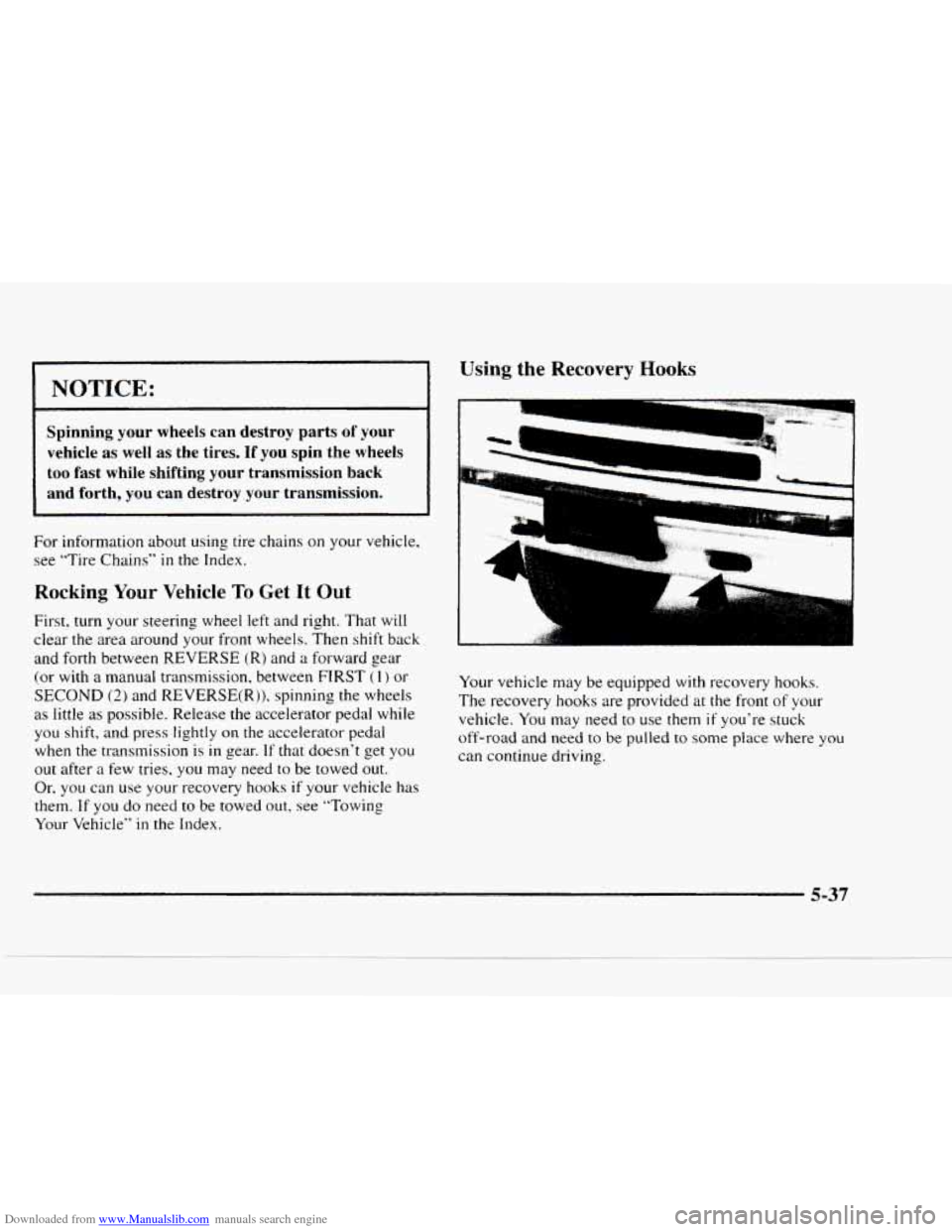
Downloaded from www.Manualslib.com manuals search engine I NOTICE: I
Spinning your wheels can destroy parts of your
vehicle as well as the tires. If you spin the wheels
too fast while shifting your transmission back
and forth,
you can destroy your transmission.
For information about using tire chains on your vehicle,
see “Tire Chains”
in the Index.
Rocking Your Vehicle To Get It Out
First, turn your steering wheel left and right. That will
clear
the area around your front wheels. Then shift back
and forth between
REVERSE (R) and a forward gear
(or with a manual transmission, between FIRST ( 1) or
SECOND (2) and REVERSE(R)), spinning the wheels
as little as possible. Release the accelerator pedal while
you shift, and press lightly on the accelerator pedal
when the transmission is
in gear. If that doesn’t get you
out after a few tries, you may need to be towed out.
Or, you can use your recovery hooks if your vehicle has
them. If you do need to be towed out, see ”Towing
Your Vehicle”
in the Index.
Using the Recovery Hooks
P
Your vehicle may be equipped with recovery hooks.
The recovery
hooks are provided at the front of your
vehicle. You may need to use them
if you’re stuck
off-road and need
to be pulled to some place where you
can continue driving.
5-37
Page 261 of 402
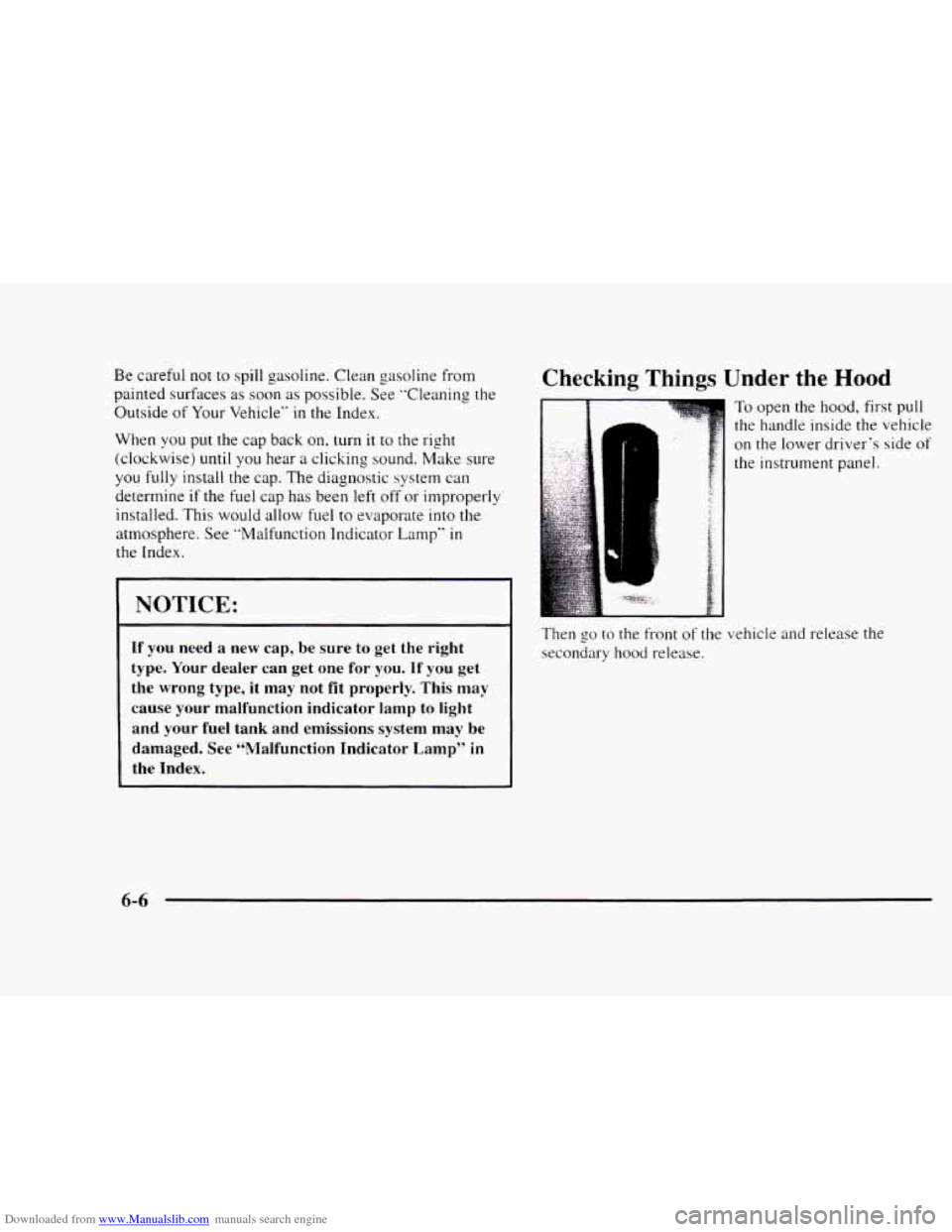
Downloaded from www.Manualslib.com manuals search engine Be careful not to spill gasoline. Clean gasoline from
painted surfaces as soon as possible. See "Cleaning the
Outside
of Your Vehicle" in the Index.
When you
put the cap back on, turn it to the right
(clockwise)
until you hear a clicking sound. Make sure
you fully install the cap. The diagnostic system can
determine
if the fuel cap has been left off or improperly
installed. This would allow fuel
to evaporate into the
atmosphere. See "Malfunction Indicator Lamp"
in
the Index.
NOTICE:
If you need a new cap, be sure to get the right
type. Your dealer
can get one for you. If you get
the wrong type, it may not
fit properly. This may
cause your malfunction indicator lamp to light and your fuel tank and emissions system may be
damaged. See "Malfunction Indicator Lamp"
in
the Index.
Checking Things Under the Hood
1
To open the hood, first pull
the handle inside the vehicle
on the lower driver's side of
the instrument panel.
Then
go to the front of the vehicle and release the
secondary hood release.
6-6
Page 274 of 402
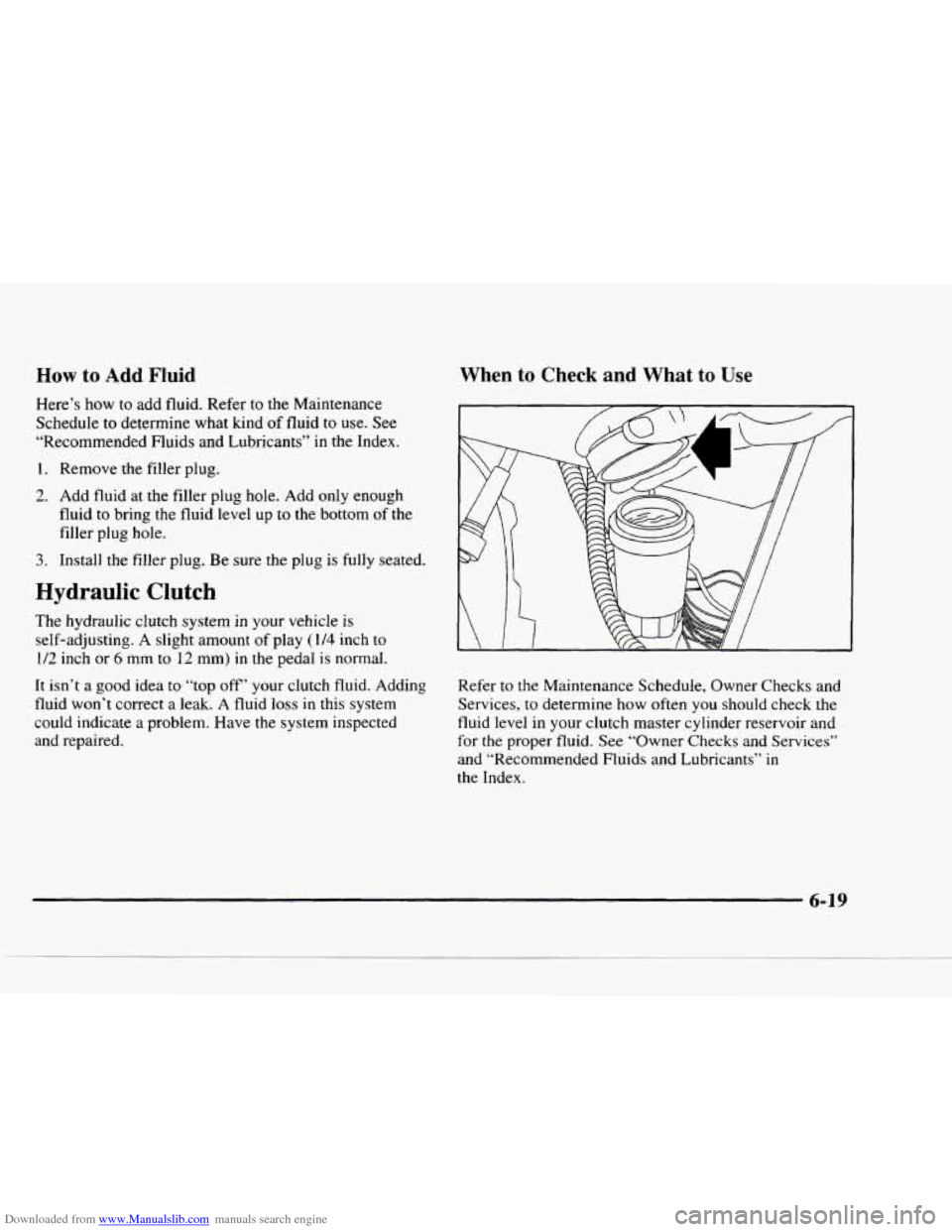
Downloaded from www.Manualslib.com manuals search engine How to Add Fluid
Here’s how to add fluid. Refer to the Maintenance
Schedule to determine what kind
of fluid to use. See
“Recommended Fluids and Lubricants” in the Index.
I. Remove the filler plug.
2. Add fluid at the filler plug hole. Add only enough
fluid to bring the fluid level
up to the bottom of the
filler plug hole.
3. Install the filler plug. Be sure the plug is fully seated.
Hydraulic Clutch
The hydraulic clutch system in your vehicle is
self-adjusting.
A slight amount of play (1/4 inch to
112 inch or 6 mm to 12 mm) in the pedal is normal.
It isn’t a good idea
to “top off’ your clutch fluid. Adding
fluid won’t correct a leak.
A fluid loss in this system
could indicate a problem. Have the system inspected
and repaired.
When to Check and What to Use
Refer to the Maintenance Schedule, Owner Checks and
Services, to determine how often you should check the
fluid level in your clutch master cylinder reservoir and
for the proper fluid. See “Owner Checks and Services”
and “Recommended Fluids and Lubricants” in
the Index.
6-19
Page 278 of 402
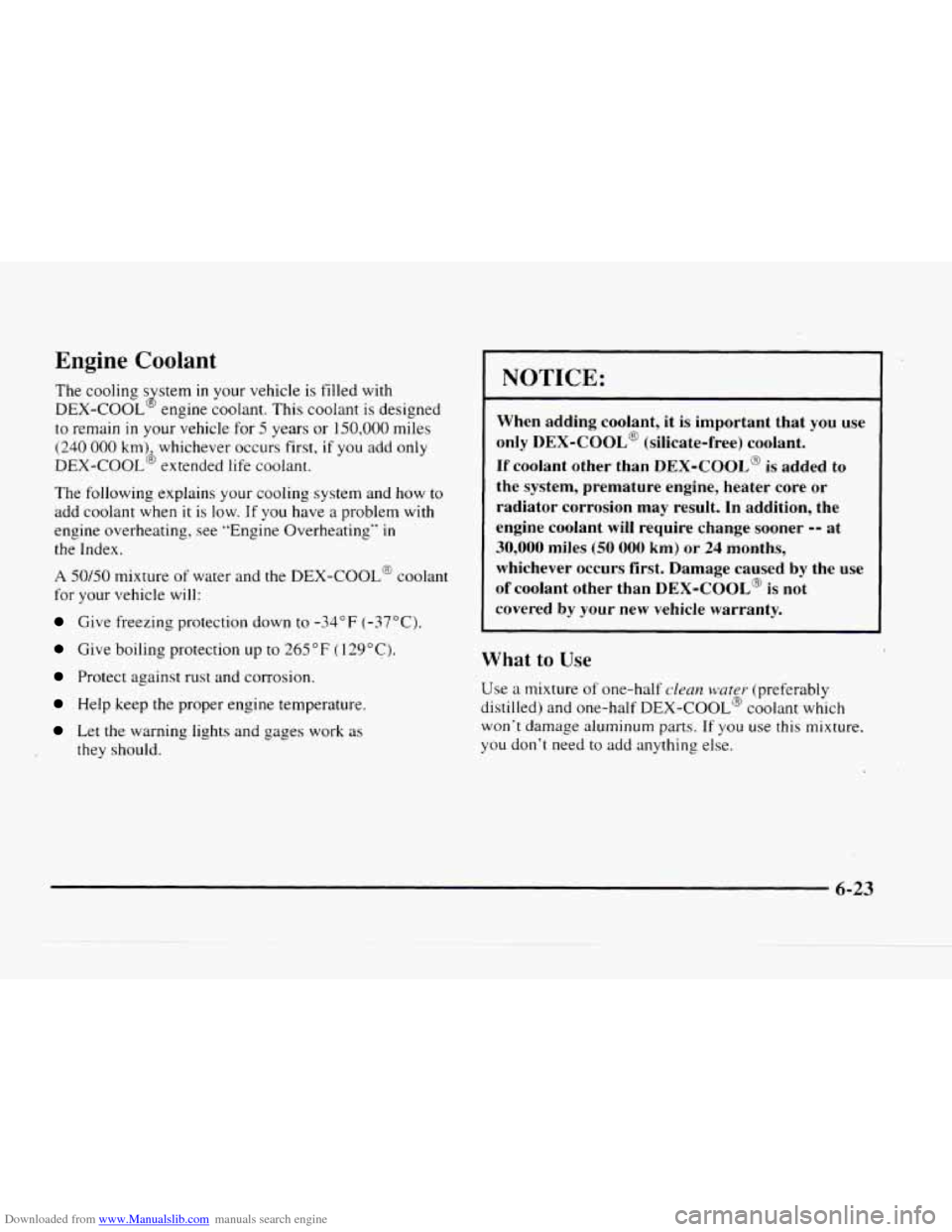
Downloaded from www.Manualslib.com manuals search engine Engine Coolant
The cooling s stem in your vehicle is filled with
DEX-COOL engine coolant. This cooIant is designed
to remain in your vehicle for 5 years or 150,000 miles
(240
000 km) whichever occurs first, if you add only
DEX-COOL’ extended life coolant.
The following explains your cooling system and
how to
add coolant when
it is low. If you have a problem with
engine overheating, see “Engine Overheating”
in
the Index.
A 50/50 mixture of water and the DEX-COOL@ coolant
for your vehicle will:
Give freezing protection down to -34°F (-37°C).
Give boiling protection up to 265 “F ( 129°C).
Protect against rust and corrosion.
Help keep the proper engine temperature.
Let the warning lights and gages work as
J
they should.
NOTICE:
When adding coolant, it is important that you use
only
DEX-COOL@ (silicate-free) coolant.
If coolant other than DEX-COOL@ is added to
I the system, premature engine, heater core or
radiator corrosion may result. In addition, the
engine coolant
will require change sooner -- at
30,000 miles (50 000 km) or 24 months,
whichever occurs first. Damage caused
by the use
of coolant other than DEX-COOL@ is not
covered
by your new vehicle warranty.
What to Use
Use a mixture of one-half clean water (preferably
distilled) and one-half DEX-COOL@ coolant which
won’t damage aluminum parts.
If you use this mixture.
you don’t need to add anything else.
6-23
Page 300 of 402
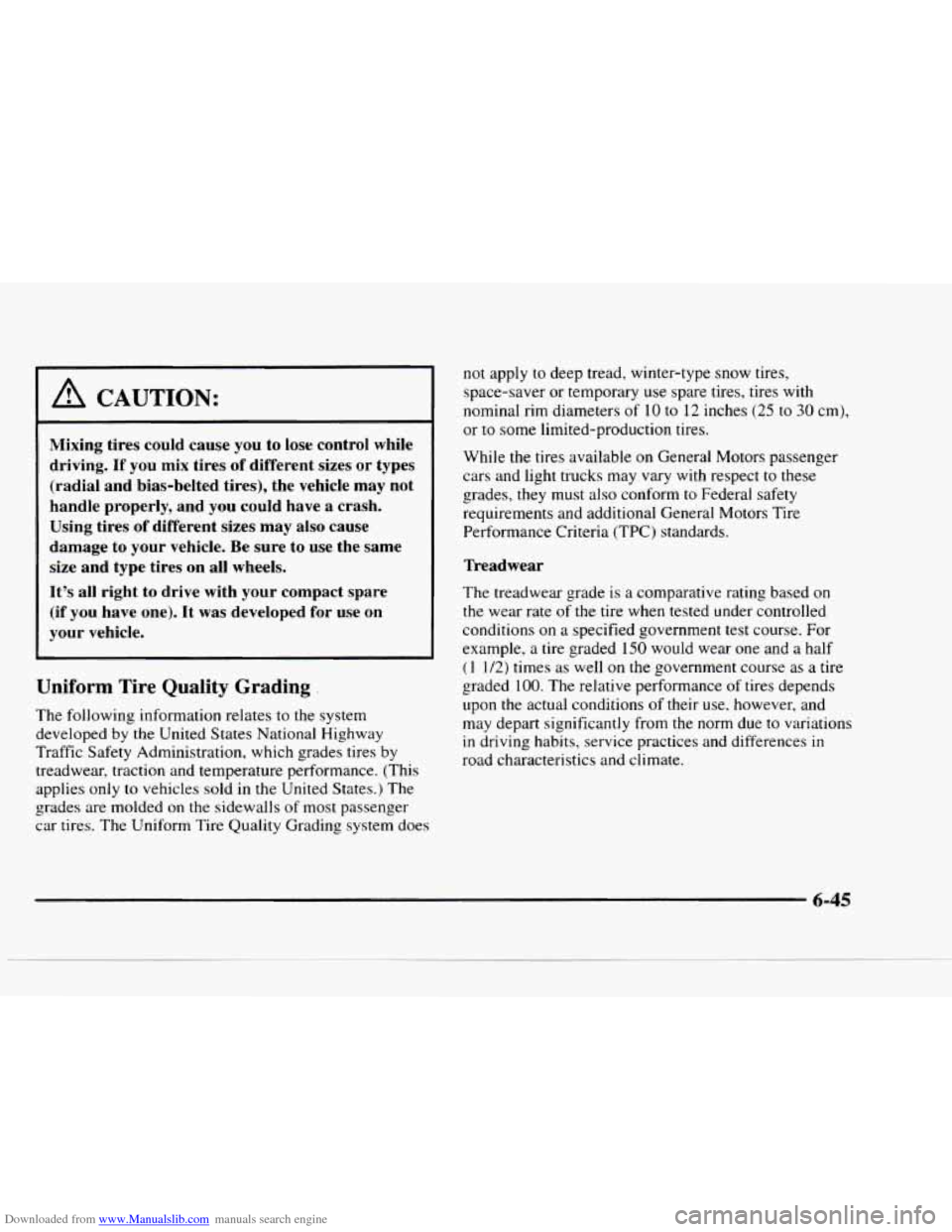
Downloaded from www.Manualslib.com manuals search engine I A CAUTION:
Mixing tires could cause you to lose control while
driving.
If you mix tires of different sizes or types
(radial and bias-belted tires), the vehicle may not
handle properly, and you could have a crash.
Using tires of different sizes may
also cause
damage to your vehicle. Be sure to use the same
size and type tires on all wheels.
It’s all right to drive with your compact spare
(if you have one). It was developed for use on
your vehicle.
Uniform Tire Quality Grading
The following information relates to the system
developed by
the United States National Highway
Traffic Safety Administration, which grades tires by
treadwear, traction and temperature performance. (This
applies only
to vehicles sold in the United States.) The
grades are molded on the sidewalls
of most passenger
car tires.
The Uniform Tire Quality Grading system does
not apply to deep tread, winter-type snow tires,
space-saver or temporary use spare tires, tires with
nominal rim diameters
of 10 to 12 inches (25 to 30 cm),
or
to some lirnited-production tires.
While the tires available
on General Motors passenger
cars and light trucks may vary with respect
to these
grades, they must also conform
to Federal safety
requirements and additional General Motors Tire
Performance Criteria (TPC) standards.
Treadwear
The treadwear grade is a comparative rating based on
the wear rate of the tire when tested under controlled
conditions on a specified government test course. For
example, a tire graded
150 would wear one and a half
(1 1/2) times as well on the government course as a tire
graded
100. The relative performance of tires depends
upon
the actual conditions of their use, however, and
may depart significantly from the norm due to variations
in driving habits, service practices and differences
in
road characteristics and climate.
6-45
Page 305 of 402
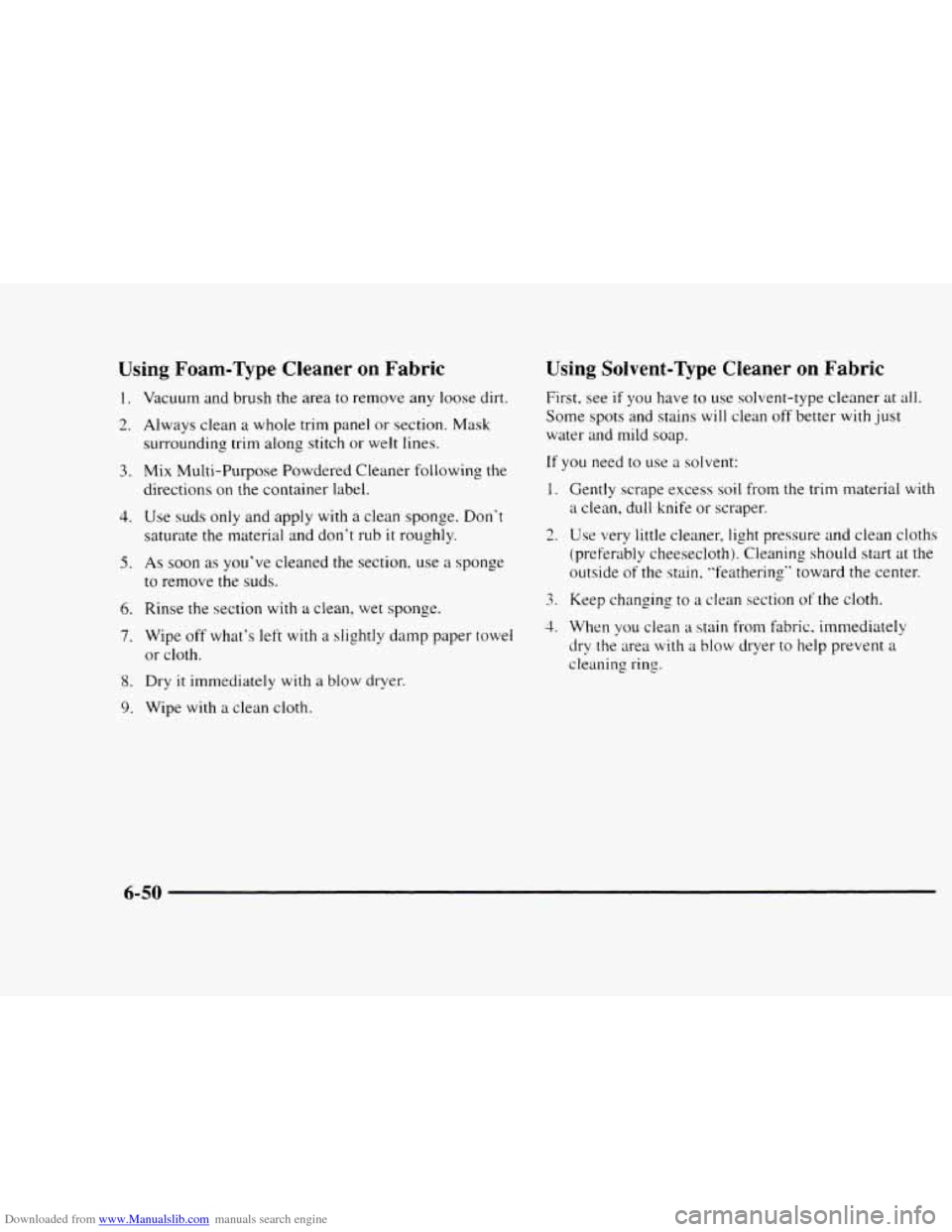
Downloaded from www.Manualslib.com manuals search engine Using Foam-Type Cleaner on Fabric
1.
2.
3.
4.
5.
6.
7.
8.
9.
Vacuum and brush the area to remove any loose dirt.
Always clean a whole trim panel
or section. Mask
surrounding trim along stitch or welt lines.
Mix Multi-Purpose Powdered Cleaner following the
directions
on the container label.
Use suds only and apply with a clean sponge. Don‘t
saturate the material and don’t rub
it roughly.
As soon as you’ve cleaned the section, use a sponge
to remove the suds.
Rinse the section with a clean, wet sponge.
Wipe off what’s left
with a slightly damp paper towel
or cloth.
Dry
it imnlediately with a blow dryer.
Wipe with
a clean cloth.
Using Solvent-Qpe Cleaner on Fabric
First. see if you have to use solvent-type cleaner at all.
Some spots and stains
will clean off better with just
water and mild soap.
If you need to use a solvent:
1. Gently scrape excess soil from the trim material with
a clean. dull knife or scraper.
2. Use very little cleaner, light pressure and clean cloths
(preferably cheesecloth). Cleaning should start at the
outside
of the stain, “feathering” toward the center.
3. Keep changing to a clean section of the cloth.
4. When you clean it stain from fabric. immediately
dry the area
with a blow dryer to help prevent a
cleaning
ring.
6-50
Page 306 of 402
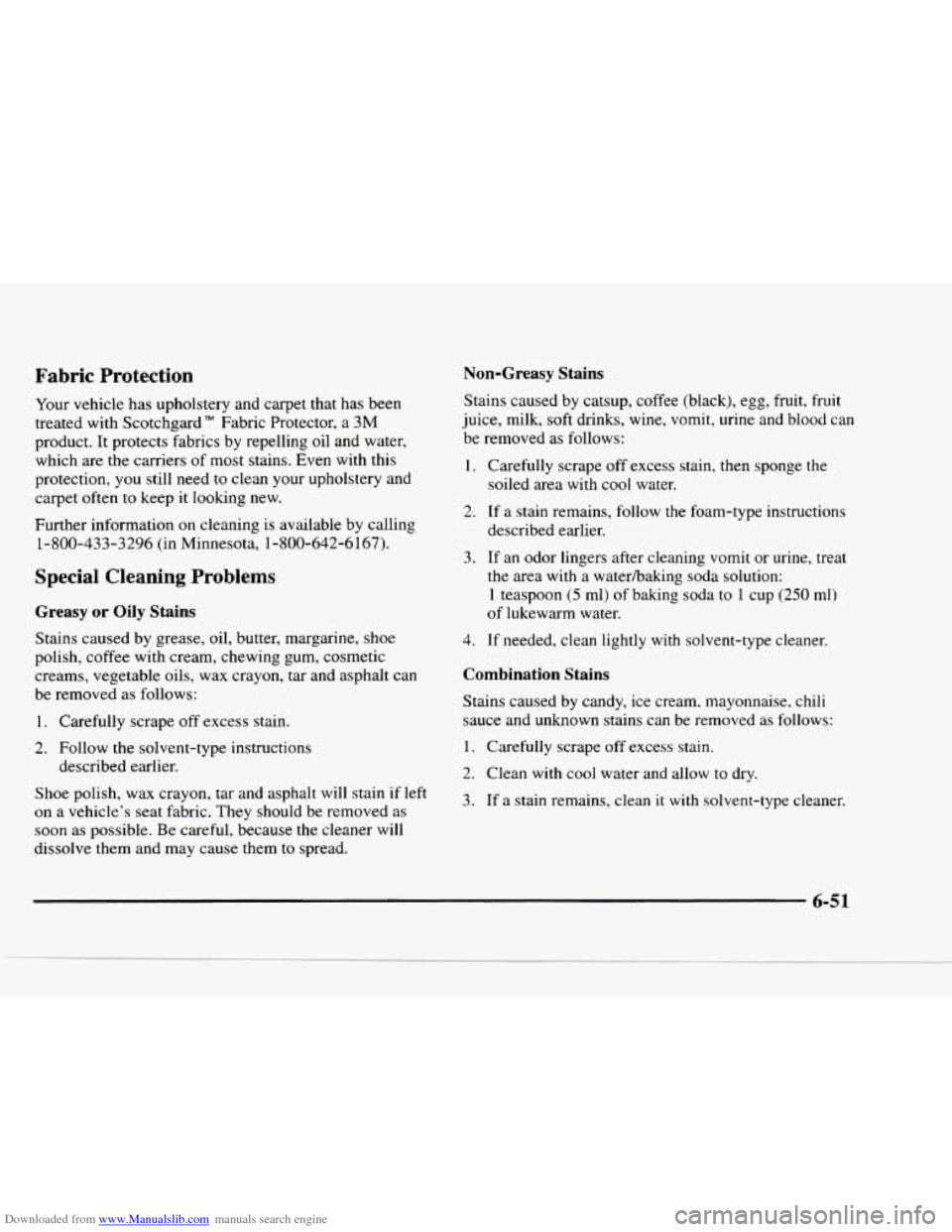
Downloaded from www.Manualslib.com manuals search engine Fabric Protection Non-Greasy Stains
Stains caused by catsup, coffee (black), egg, fruit, fruit
juice, milk, soft drinks, wine, vomit, urine
and blood can
be removed as follows:
Your
vehicle has upholstery and carpet
that has been
treated with Scotchgard" Fabric Protector, a
3M
product. It protects fabrics by repelling oil and water,
which are the carriers of most stains. Even with this
protection, you still need to clean your upholstery and
carpet often to keep
it looking new.
Further information on cleaning is available by calling
1-800-433-3296 (in Minnesota, 1-800-642-6 167).
Special Cleaning Problems
Greasy or Oily Stains
Stains caused by grease, oil, butter, margarine, shoe
polish, coffee with cream, chewing gum, cosmetic
creams, vegetable oils, wax crayon, tar and asphalt can
be removed as follows:
1. Carefully scrape off excess stain.
2. Follow the solvent-type instructions
described earlier.
Shoe polish, wax crayon, tar and asphalt will stain
if left
on a vehicle's seat fabric. They should be removed as
soon as possible. Be careful, because the cleaner
will
dissolve them and may cause them to spread.
1.
2.
3.
4.
Carefully scrape off excess stain, then sponge the
soiled area
with cool water.
If a stain remains, follow the foam-type instructions
described earlier.
If an odor lingers after cleaning vomit or urine, treat
the area with a waterhaking soda solution:
1 teaspoon (5 ml) of baking soda to 1 cup (250 ml)
of lukewarm water.
If needed, clean lightly
with solvent-type cleaner.
Combination Stains
Stains caused by candy, ice cream, mayonnaise, chili
sauce and unknown stains can be removed as follows:
1. Carefully scrape off excess stain.
2. Clean with cool water and allow to dry.
3. If a stain remains, clean it with solvent-type cleaner.
6-51
Page 314 of 402
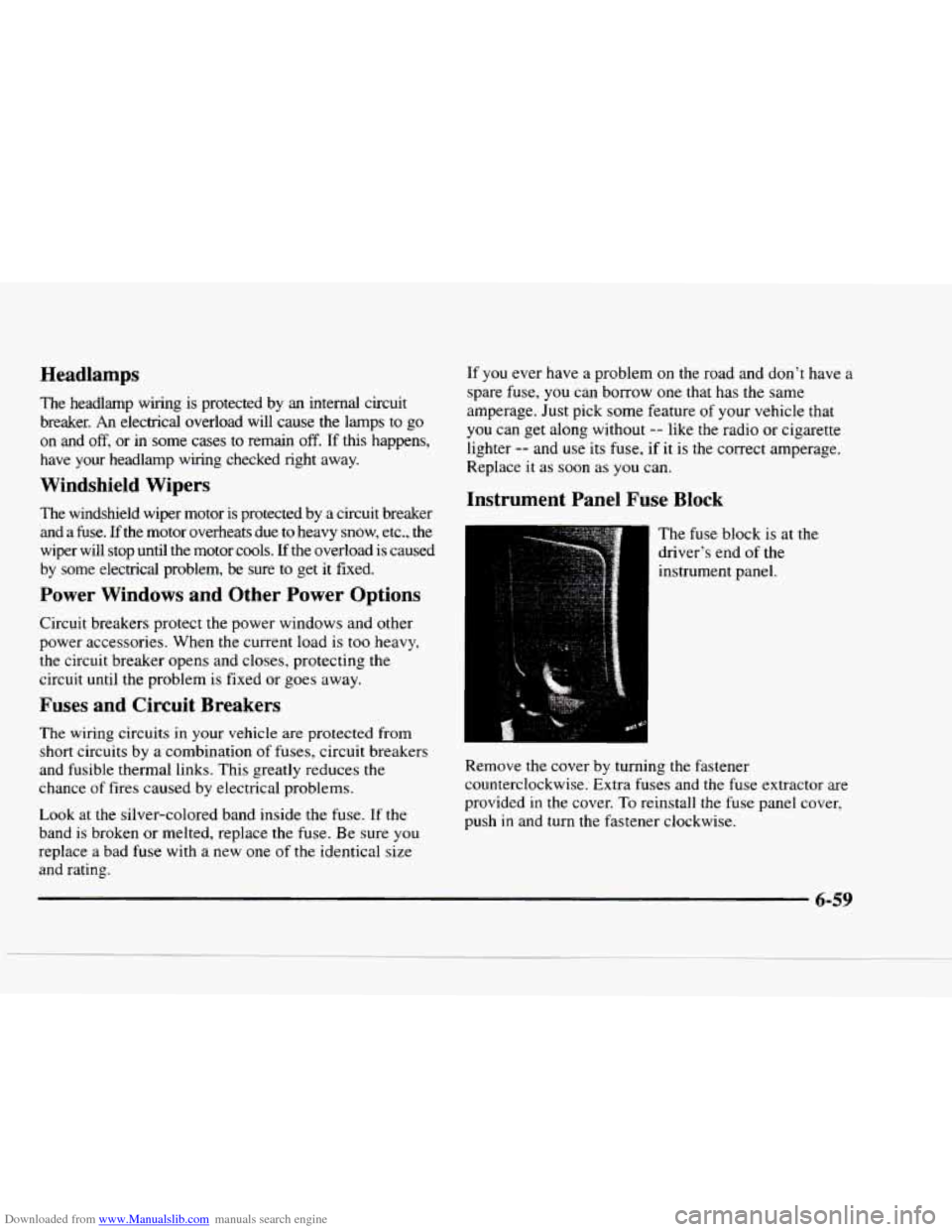
Downloaded from www.Manualslib.com manuals search engine Headlamps
The headlamp wiring is protected by an internal circuit
breaker.
An electrical overload will cause the lamps to go
on and off, or in some cases to remain off. If this happens,
have your headlamp wiring checked right away.
Windshield Wipers
The windshield wiper motor is protected by a circuit breaker
and a fuse.
If the motor overheats due to heavy snow, etc., the
wiper will stop until the motor cools.
If the overload is caused
by some electrical problem, be sure
to get it fixed.
Power Windows and Other Power Options
Circuit breakers protect the power windows and other
power accessories. When
the current load is too heavy,
the circuit breaker opens and closes, protecting the
circuit until the problem is fixed or goes away.
Fuses and Circuit Breakers
The wiring circuits in your vehicle are protected from
short circuits by a combination of fuses, circuit breakers
and fusible thermal links. This greatly reduces the
chance
of fires caused by electrical problems.
Look at the silver-colored band inside the fuse. If the
band is broken or melted, replace the fuse. Be sure you
replace a bad fuse with a new one of the identical size
and rating. If you
ever have a problem on the road and don't have
a
spare fuse, you can borrow one that has the same
amperage. Just pick some feature
of your vehicle that
you
can get along without -- like the radio or cigarette
lighter
-- and use its fuse, if it is the correct amperage.
Replace it as soon as
you can.
Instrument Panel Fuse Block
The fuse block is at the
driver's end
of the
instrument panel.
Remove the cover by turning the fastener
counterclockwise. Extra fuses and the fuse extractor
are
provided in the cover. To reinstall the fuse panel cover,
push
in and turn the fastener clockwise.